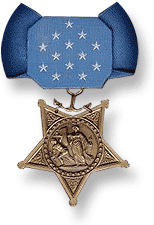Jackson C. Pharris facts for kids
Quick facts for kids
Jackson Charles Pharris
|
|
|---|---|
 |
|
| Born | June 26, 1912 Columbus, Georgia, US |
| Died | October 17, 1966 (aged 54) Pearl Harbor, Hawaii |
| Place of burial | |
| Allegiance | United States |
| Service/ |
|
| Years of service | 1933–1948 |
| Rank | Lieutenant Commander |
| Unit | USS California (BB-44) |
| Battles/wars | World War II |
| Awards | Medal of Honor |
Jackson Charles Pharris (born June 26, 1912 – died October 17, 1966) was a brave officer in the United States Navy. He earned the highest military award, the Medal of Honor, for his amazing courage during the attack on Pearl Harbor in World War II.
Contents
Jackson C. Pharris grew up in Columbus, Georgia. He was the oldest of five children. He joined the United States Navy on April 25, 1933. In September 1933, he started working on the ship USS California (BB-44) as a gunner. A gunner is someone who operates the ship's weapons.
He served on another ship, the USS Mississippi, until December 1940. Then, in January 1941, Pharris returned to the USS California. This ship arrived at Pearl Harbor in Hawaii on November 8, 1941.
Heroism at Pearl Harbor
On December 7, 1941, the Japanese military launched a surprise attack on Pearl Harbor. Jackson Pharris was on board the USS California when the attack happened. His actions that day earned him the Navy Cross, which was later changed to the even higher Medal of Honor.
What He Did During the Attack
Pharris was in charge of a repair team on the ship's third deck. When the first Japanese torpedo hit the ship, it exploded almost right where he was standing. The powerful blast threw him into the ceiling and then back down to the floor. He was badly hurt and stunned.
But Pharris quickly recovered. Even though he was injured, he immediately started helping. He organized a human chain to pass ammunition by hand to the anti-aircraft guns. These guns were firing back at the enemy planes.
Water and oil began flooding into the ship where the side had been ripped open. Many sailors were getting sick from the oil fumes. The ship lost power and started to tilt heavily to one side after a second torpedo hit. Pharris bravely ordered his team to flood other parts of the ship to try and balance it out.
He passed out twice because of the terrible fumes and his injuries. But each time, he woke up and kept working. He kept pushing to get ammunition to the guns. He also risked his life many times to go into the flooded areas. He pulled unconscious shipmates to safety, saving them from drowning in the oil and water.
His amazing leadership and loyalty helped keep the USS California fighting during the attack. He saved many lives that day.
After the Attack
Because of his injuries, Pharris stayed in the Naval Hospital at Pearl Harbor until March 1942. After he got better, he went back to the USS California. In July 1942, he became a commissioned officer, which means he was promoted to a higher rank.
In January 1943, he had to go back to the hospital. He collapsed because oil from the attack was still in his lungs. He returned to duty in June of that year.
Later Service and Injuries
In October 1944, Pharris moved to Boston, Massachusetts. He joined a new ship called the USS Saint Paul (CA-73), which was a large warship called a heavy cruiser. This ship sailed to Japan to attack targets on the Japanese mainland.
In September 1945, just five days after Japan surrendered, Lieutenant Pharris was on deck. A Japanese kamikaze plane suddenly flew towards the ship. A kamikaze was a plane whose pilot intended to crash it into an enemy target. Pharris quickly ordered his crew to take cover. He then directed the ship's guns himself and shot the plane down. The force of the guns firing broke his back.
Pharris was taken to a hospital in Oakland, California. He was later moved to another hospital in Long Beach, California. He was released from the hospital in April 1946. In May 1948, he was medically retired from the Navy as a lieutenant commander due to his injuries.
On June 25, 1948, President Harry S. Truman personally gave him the Medal of Honor.
Personal Life and Legacy
In November 1942, Pharris met Elizabeth Potter. They were married on August 24, 1943. After he retired from the Navy, the Pharris family settled in Rolling Hills Estates, California. Jackson Pharris went to college and earned a degree in Commerce in 1956.
On October 16, 1966, Pharris collapsed while attending an event for Medal of Honor recipients. He died the next day from a heart attack. He was buried at Arlington National Cemetery, a special cemetery for military heroes. His wife, Elizabeth, was also buried there after she passed away in 2002.
Namesake Ship
To honor his bravery, a destroyer escort ship was named after him in 1972. It was called the USS Pharris (DE-1094).

